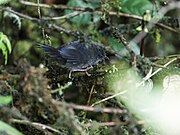
Rhinocryptidae is a family of passerine birds in the parvorder Furnariida. [1] Most species in the family are called tapaculos, although some are known as huet-huets, gallitos, bristlefronts, turcas, or bamboowrens. [2] Tapaculos are endemic to the Neotropics and inhabit dense undergrowth in a variety of habitats, from lowland tropical rainforest to páramo and puna grassland high in the Andes. Tapaculos are usually extremely secretive, ground-dwelling birds that are best detected by their vocalizations. Several species of tapaculos may even be flightless. [1] Tapaculos are generally blackish or grayish with rufous-and-black markings on the tail and sides, and are best identified by their calls. [3] Several species of tapaculos are threatened with extinction, with habitat loss being the principal threat to most species. [1] Stresemann's bristlefront is considered to be critically endangered by the International Union for Conservation of Nature, with a maximum estimated population of 49 mature individuals, and another seven species are considered to be endangered.
There are currently 65 species of tapaculos recognized by the International Ornithologists' Union, distributed among 12 genera, 7 of which have only one species. The most species-rich genus is Scytalopus, with 49 species. [2] Tapaculo diversity is highest in the Andes, where a combination of the poor flying ability of Scytalopus tapaculos and complex topography has led to high levels of population isolation, with more than 30 species having been described from the region. [3] [4] Despite their high diversity, Scytalopus tapaculos are difficult to differentiate on the basis of appearance and are generally described based on genetic data and differences in vocalizations. [3] The number of known tapaculo species has drastically increased as the amount of genetic and vocal data available has increased, but diversity within the genus is likely still underestimated. [3]
Conventions
| Conservation status | |
|---|---|
| EX | Extinct (0 species) |
| EW | Extinct in the wild (0 species) |
| CR | Critically Endangered (1 species) |
| EN | Endangered (7 species) |
| VU | Vulnerable (0 species) |
| NT | Near threatened (8 species) |
| LC | Least concern (44 species) |
| Other categories | |
| DD | Data deficient (0 species) |
| NE | Not evaluated (5 species) |
Conservation status codes listed follow the International Union for Conservation of Nature (IUCN) Red List of Threatened Species. Range maps are provided wherever possible; if a range map is not available, a description of the tapaculo's range is provided. Ranges are based on the IOC World Bird List for that species unless otherwise noted. Population estimates are of the number of mature individuals and are taken from the IUCN Red List.
This list follows the taxonomic treatment (designation and order of species) and nomenclature (scientific and common names) of version 13.2 of the IOC World Bird List. [2] Where the taxonomy proposed by the IOC World Bird List conflicts with the taxonomy followed by the IUCN [a] or the 2023 edition of The Clements Checklist of Birds of the World, [6] the disagreement is noted next to the species's common name (for nomenclatural disagreements) or scientific name (for taxonomic disagreements).
Classification
The International Ornithologists' Union (IOU) recognizes 65 species of tapaculos in 12 genera; [2] some other authorities recognise as few as 60 species. [5] This list does not include hybrid species, extinct prehistoric species, or putative species not yet accepted by the IOU.
- Genus Acropternis: one species
- Genus Pteroptochos: three species
- Genus Scelorchilus: two species
- Genus Rhinocrypta: one species
- Genus Teledromas: one species
- Genus Liosceles: one species
- Genus Psilorhamphus: one species
- Genus Merulaxis: two species
- Genus Eugralla: one species
- Genus Myornis: one species
- Genus Eleoscytalopus: two species
- Genus Scytalopus: forty-nine species
| |||||||||||||||||||||||||||||||||||||||||||||||||||||||||||||||||||||
| Cladogram based on a 2020 study by Harvey et al. [7] |
Rhinocryptids
| Common name | Scientific name and subspecies | Range | IUCN status and estimated population |
|---|---|---|---|
| Ocellated tapaculo | A. orthonyx ( Lafresnaye, 1843) Two subspecies
|
Northwestern South America
|
LC
|
| Common name | Scientific name and subspecies | Range | IUCN status and estimated population |
|---|---|---|---|
| Chestnut-throated huet-huet | P. castaneus Philippi & Landbeck, 1864 |
Central Chile and west-central Argentina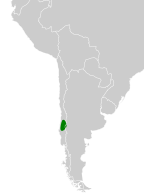
|
LC
|
| Black-throated huet-huet | P. tarnii ( King, P. P., 1831) |
Southwestern South America
|
LC
|
| Moustached turca | P. megapodius Kittlitz, 1830 Two subspecies
|
Chile
|
LC
|
| Common name | Scientific name and subspecies | Range | IUCN status and estimated population |
|---|---|---|---|
| White-throated tapaculo | S. albicollis ( Kittlitz, 1830) Two subspecies
|
Chile
|
LC
|
| Chucao tapaculo | S. rubecula ( Kittlitz, 1830) Two subspecies
|
Southwestern South America
|
LC
|
| Common name | Scientific name and subspecies | Range | IUCN status and estimated population |
|---|---|---|---|
| Crested gallito | R. lanceolata ( Geoffroy Saint-Hilaire, 1832) Two subspecies
|
South-central South America
|
LC
|
| Common name | Scientific name and subspecies | Range | IUCN status and estimated population |
|---|---|---|---|
| Sandy gallito | T. fuscus ( Sclater, P. L. & Salvin, 1873) |
Central Argentina
|
LC
|
| Common name | Scientific name and subspecies | Range | IUCN status and estimated population |
|---|---|---|---|
| Rusty-belted tapaculo | L. thoracicus ( Sclater, P. L., 1865) Three subspecies
|
Western and southwestern
Amazon rainforest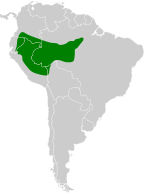
|
LC
|
| Common name | Scientific name and subspecies | Range | IUCN status and estimated population |
|---|---|---|---|
| Spotted bamboowren | P. guttatus ( Ménétriés, 1835) |
Brazil and northeastern Argentina
|
LC
|
| Common name | Scientific name and subspecies | Range | IUCN status and estimated population |
|---|---|---|---|
| Slaty bristlefront | M. ater Lesson, R. P., 1831 |
Southeastern Brazil
|
LC
|
|
Stresemann's bristlefront
|
M. stresemanni Sick, 1960 |
Eastern Brazil
|
CR
|
| Common name | Scientific name and subspecies | Range | IUCN status and estimated population |
|---|---|---|---|
| Ochre-flanked tapaculo | E. paradoxa ( Kittlitz, 1830) |
Southwestern South America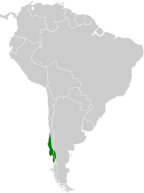
|
LC
|
| Common name | Scientific name and subspecies | Range | IUCN status and estimated population |
|---|---|---|---|
| Ash-colored tapaculo | M. senilis ( Lafresnaye, 1840) |
Northwestern South America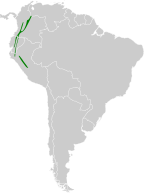
|
LC
|
| Common name | Scientific name and subspecies | Range | IUCN status and estimated population |
|---|---|---|---|
| White-breasted tapaculo | E. indigoticus ( Wied, 1831) |
Southeastern Brazil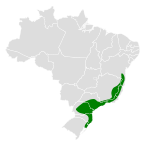
|
LC
|
| Bahia tapaculo | E. psychopompus ( Teixeira & Carnevalli, 1989) |
Eastern Brazil
|
EN
|
| Common name | Scientific name and subspecies | Range | IUCN status and estimated population |
|---|---|---|---|
| Marsh tapaculo | S. iraiensis Bornschein, Reinert & Pichorim, 1998 |
Southern Brazil
|
EN
|
| Diamantina tapaculo | S. diamantinensis Bornschein, Maurício, Belmonte-Lopes, Mata & Bonatto, 2007 |
Northeastern Brazil
|
EN
|
| Brasília tapaculo | S. novacapitalis Sick, 1958 |
Southern Brazil
|
EN
|
| Rock tapaculo | S. petrophilus Whitney, de Vasconcelos, Silveira & Pacheco, 2010 |
Southeastern Brazil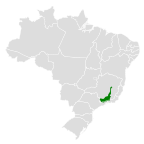
|
LC
|
| Planalto tapaculo | S. pachecoi Maurício, 2005 |
Southeastern Brazil and northeastern Argentina
|
LC
|
|
Boa Nova tapaculo
|
S. gonzagai Maurício, Belmonte-Lopes, Pacheco, Silveira, Whitney & Bornschein, 2014 |
Southeastern Brazil
|
EN
|
| Mouse-colored tapaculo | S. speluncae ( Ménétries, 1835) |
Southeastern Brazil
|
LC
|
|
Dusky tapaculo
|
S. fuscus Gould, 1837 |
Central Chile
|
LC
|
| Magellanic tapaculo | S. magellanicus ( Gmelin, J. F., 1789) |
Chile and Argentina
|
LC
|
| Ancash tapaculo | S. affinis Zimmer, J. T., 1939 |
Western Peru
|
LC
|
|
White-winged tapaculo
|
S. krabbei Schulenberg, Lane, Spencer, AJ, Angulo & Cadena, 2020 |
North-central Peru
|
NE
|
| Loja tapaculo | S. androstictus Krabbe and Cadena, 2010 |
Southeastern Ecuador and northern Peru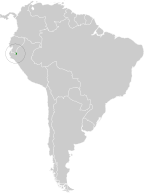
|
NE
|
| Paramo tapaculo | S. opacus Zimmer, J. T., 1941 |
Central Colombia to south-central Ecuador
|
LC
|
|
Paramillo tapaculo
|
S. canus Chapman, 1915 |
Western Colombia
|
NT
|
| White-browed tapaculo | S. superciliaris Cabanis, 1883 Two subspecies
|
Northwestern Argentina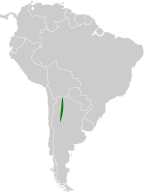
|
LC
|
| Zimmer's tapaculo | S. zimmeri Bond, J. & Meyer de Schauensee, 1940 |
Southern Bolivia and northwestern Argentina
|
LC
|
| Puna tapaculo | S. simonsi Chubb, C., 1917 |
Southeastern Peru to central Bolivia
|
LC
|
| Diademed tapaculo | S. schulenbergi Whitney, 1994 |
Southeastern Peru to central Bolivia
|
LC
|
| Vilcabamba tapaculo | S. urubambae Zimmer, J. T., 1939 |
East-central Peru
|
LC
|
|
Ampay tapaculo
|
S. whitneyi Krabbe et al., 2020 |
Southern Peru
|
NE
|
| Jalca tapaculo | S. frankeae Krabbe et al., 2020 |
Central Peru
|
NE
|
| Neblina tapaculo | S. altirostris Zimmer, J. T., 1939 |
Northern Peru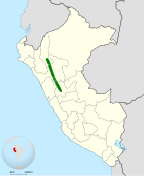
|
LC
|
| Trilling tapaculo | S. parvirostris Zimmer, J. T., 1939 |
North-central Peru to east-central Bolivia
|
LC
|
|
Bolivian tapaculo
|
S. bolivianus Allen, J. A., 1889 |
Southeastern Peru to southern Bolivia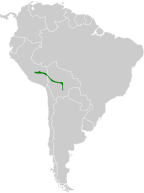
|
LC
|
| White-crowned tapaculo | S. atratus Hellmayr, 1922 Three subspecies
|
Northwestern South America
|
LC
|
| Santa Marta tapaculo | S. sanctaemartae Chapman, 1915 |
Northern Colombia
|
NT
|
| Long-tailed tapaculo | S. micropterus ( Sclater, P. L., 1858) |
Colombia to northern Peru
|
LC
|
|
Rufous-vented tapaculo
|
S. femoralis ( Tschudi, 1844) |
Central Peru
|
LC
|
|
Utcubamba tapaculo
|
S. intermedius Zimmer, J. T., 1939 |
North-central Peru
|
NE
|
|
Large-footed tapaculo
|
S. macropus Berlepsch & Stolzmann, 1896 |
Peru
|
LC
|
| Junin tapaculo | S. gettyae Hosner et al., 2013 |
Central Peru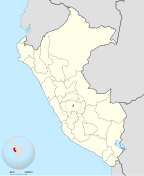
|
NT
|
|
Unicolored tapaculo
|
S. unicolor Salvin, 1895 |
West-central Peru
|
NT
|
| Tschudi's tapaculo | S. acutirostris ( Tschudi, 1844) |
Central Peru
|
LC
|
| Blackish tapaculo | S. latrans Hellmayr, 1924 Two subspecies
|
Northwestern South America
|
LC
|
| Silvery-fronted tapaculo | S. argentifrons Ridgway, 1891 Two subspecies
|
Costa Rica and Panama
|
LC
|
| Nariño tapaculo | S. vicinior Zimmer, J. T., 1939 |
Northwestern South America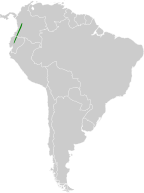
|
LC
|
|
Tacarcuna tapaculo
|
S. panamensis Chapman, 1915 |
Eastern Panama and northwestern Colombia
|
NT
|
| Chocó tapaculo | S. chocoensis Krabbe & Schulenberg, 1997 |
Eastern Panama to northwestern Ecuador
|
LC
|
|
Magdalena tapaculo
|
S. rodriguezi Krabbe et al., 2005 Two subspecies
|
Central Colombia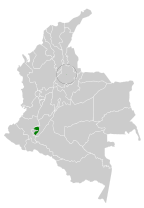
|
EN
|
| Stiles's tapaculo | S. stilesi Cuervo et al., 2005 |
Central Colombia
|
LC
|
| Tatama tapaculo | S. alvarezlopezi Cuervo et al., 2005 |
Western Colombia
|
NT
|
|
El Oro tapaculo
|
S. robbinsi Krabbe & Schulenberg, 1997 |
Southwestern Ecuador
|
EN
|
|
Caracas tapaculo
|
S. caracae Hellmayr, 1922 |
Northern Venezuela
|
LC
|
| Pale-bellied tapaculo | S. griseicollis ( Lafresnaye, 1840) Three subspecies
|
Northwestern South America
|
LC
|
| Brown-rumped tapaculo | S. latebricola Bangs, 1899 |
Northern Colombia
|
NT
|
| Perijá tapaculo | S. perijanus Avendaño et al., 2015 |
Perijá Mountains
|
NT
|
|
Mérida tapaculo
|
S. meridanus Hellmayr, 1922 Two subspecies
|
Northwestern Venezuela
|
LC
|
| Chusquea tapaculo | S. parkeri Krabbe & Schulenberg, 1997 |
Northwestern South America
|
LC
|
|
Spillmann's tapaculo
|
S. spillmanni Stresemann, 1937 |
Northwestern South America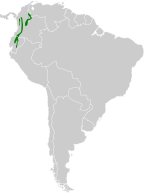
|
LC
|
Notes
- ^ The IUCN follows the taxonomy proposed by the HBW and BirdLife Taxonomic Checklist. [5]
References
- ^ a b c Winkler, David W.; Billerman, Shawn M.; Lovette, Irby J. (4 March 2020), Billerman, Shawn M.; Keeney, Brooke K.; Rodewald, Paul G.; Schulenberg, Thomas S. (eds.), "Tapaculos (Rhinocryptidae)", Birds of the World, Cornell Lab of Ornithology, doi: 10.2173/bow.rhinoc1.01, S2CID 243247124, retrieved 19 June 2023
- ^ a b c d Gill, F.; Donsker, D.; Rasmussen, P., eds. (July 2023). "Antthrushes, antpittas, gnateaters, tapaculos, crescentchests". IOC World Bird List. v 13.2. Retrieved 19 June 2023.
- ^ a b c d Krabbe, Niels K.; Schulenberg, Thomas S.; Hosner, Peter A.; Rosenberg, Kenneth V.; Davis, Tristan J.; Rosenberg, Gary H.; Lane, Daniel F.; Andersen, Michael J.; Robbins, Mark B.; Cadena, Carlos Daniel; Valqui, Thomas; Salter, Jessie F.; Spencer, Andrew J.; Angulo, Fernando; Fjeldså, Jon (5 April 2020). "Untangling cryptic diversity in the High Andes: Revision of the Scytalopus [magellanicus] complex (Rhinocryptidae) in Peru reveals three new species". The Auk. 137 (2). doi: 10.1093/auk/ukaa003. ISSN 0004-8038.
- ^ Maurício, Giovanni Nachtigall; Belmonte-Lopes, Ricardo; Pacheco, José Fernando; Silveira, Luís Fábio; Whitney, Bret M.; Bornschein, Marcos Ricardo (27 August 2014). "Taxonomy of "Mouse-colored Tapaculos" (II): An endangered new species from the montane Atlantic Forest of southern Bahia, Brazil (Passeriformes: Rhinocryptidae: Scytalopus )". The Auk. 131 (4): 643–659. doi: 10.1642/AUK-14-16.1. ISSN 0004-8038.
- ^ a b "Handbook of the Birds of the World and BirdLife International digital checklist of the birds of the world. Version 7". HBW and BirdLife International. 2022. Retrieved 19 June 2023.
- ^ Clements, James F.; Rasmussen, P. C.; Schulenberg, T. S.; Iliff, M. J.; Fredericks, T. A.; Gerbracht, J. A.; Lepage, Denis; Billerman, S. M.; Sullivan, B. L.; Wood, C. L. (2023). "The eBird/Clements checklist of Birds of the World: v2023". Clements Checklist. Archived from the original on 28 January 2024. Retrieved 28 January 2024.
- ^ Harvey, Michael G.; Bravo, Gustavo A.; Claramunt, Santiago; Cuervo, Andrés M.; Derryberry, Graham E.; Battilana, Jaqueline; Seeholzer, Glenn F.; McKay, Jessica Shearer; O’Meara, Brian C.; Faircloth, Brant C.; Edwards, Scott V.; Pérez-Emán, Jorge; Moyle, Robert G.; Sheldon, Frederick H.; Aleixo, Alexandre (11 December 2020). "The evolution of a tropical biodiversity hotspot". Science. 370 (6522): 1343–1348. Bibcode: 2020Sci...370.1343H. doi: 10.1126/science.aaz6970. hdl: 10138/329703. ISSN 0036-8075. PMID 33303617.
- ^ BirdLife International (2022). "Acropternis orthonyx". IUCN Red List of Threatened Species. 2022: e.T22703554A216501012. Retrieved 1 July 2023.
- ^ BirdLife International (2018). "Pteroptochos castaneus". IUCN Red List of Threatened Species. 2018: e.T22703421A130328965. doi: 10.2305/IUCN.UK.2018-2.RLTS.T22703421A130328965.en. Retrieved 1 July 2023.
- ^ BirdLife International (2018). "Pteroptochos tarnii". IUCN Red List of Threatened Species. 2018: e.T22703426A130329211. doi: 10.2305/IUCN.UK.2018-2.RLTS.T22703426A130329211.en. Retrieved 1 July 2023.
- ^ BirdLife International (2022). "Pteroptochos megapodius". IUCN Red List of Threatened Species. 2022: e.T22703431A216470947. Retrieved 1 July 2023.
- ^ BirdLife International (2022). "Scelorchilus albicollis". IUCN Red List of Threatened Species. 2022: e.T22703434A216471919. Retrieved 1 July 2023.
- ^ BirdLife International (2018). "Scelorchilus rubecula". IUCN Red List of Threatened Species. 2018: e.T22703437A130329453. doi: 10.2305/IUCN.UK.2018-2.RLTS.T22703437A130329453.en. Retrieved 1 July 2023.
- ^ BirdLife International (2016). "Rhinocrypta lanceolata". IUCN Red List of Threatened Species. 2016: e.T22703440A93923185. doi: 10.2305/IUCN.UK.2016-3.RLTS.T22703440A93923185.en. Retrieved 1 July 2023.
- ^ BirdLife International (2016). "Teledromas fuscus". IUCN Red List of Threatened Species. 2016: e.T22703443A93923357. doi: 10.2305/IUCN.UK.2016-3.RLTS.T22703443A93923357.en. Retrieved 1 July 2023.
- ^ BirdLife International (2022). "Liosceles thoracicus". IUCN Red List of Threatened Species. 2022: e.T22703446A216499976. Retrieved 1 July 2023.
- ^ BirdLife International (2022). "Psilorhamphus guttatus". IUCN Red List of Threatened Species. 2022: e.T22703471A210323372. doi: 10.2305/IUCN.UK.2022-1.RLTS.T22703471A210323372.en. Retrieved 1 July 2023.
- ^ BirdLife International (2022). "Merulaxis ater". IUCN Red List of Threatened Species. 2022: e.T22703474A210365334. doi: 10.2305/IUCN.UK.2022-1.RLTS.T22703474A210365334.en. Retrieved 1 July 2023.
- ^ BirdLife International (2021). "Merulaxis stresemanni". IUCN Red List of Threatened Species. 2021: e.T22703477A161689029. doi: 10.2305/IUCN.UK.2021-3.RLTS.T22703477A161689029.en. Retrieved 1 July 2023.
- ^ BirdLife International (2018). "Eugralla paradoxa". IUCN Red List of Threatened Species. 2018: e.T22703480A130329722. doi: 10.2305/IUCN.UK.2018-2.RLTS.T22703480A130329722.en. Retrieved 1 July 2023.
- ^ BirdLife International (2016). "Myornis senilis". IUCN Red List of Threatened Species. 2016: e.T22703483A93925412. doi: 10.2305/IUCN.UK.2016-3.RLTS.T22703483A93925412.en. Retrieved 1 July 2023.
- ^ BirdLife International (2022). "Eleoscytalopus indigoticus". IUCN Red List of Threatened Species. 2022: e.T22703546A210360985. doi: 10.2305/IUCN.UK.2022-1.RLTS.T22703546A210360985.en. Retrieved 1 July 2023.
- ^ BirdLife International (2022). "Eleoscytalopus psychopompus". IUCN Red List of Threatened Species. 2022: e.T22703535A210332902. doi: 10.2305/IUCN.UK.2022-1.RLTS.T22703535A210332902.en. Retrieved 1 July 2023.
- ^ BirdLife International (2016). "Scytalopus iraiensis". IUCN Red List of Threatened Species. 2016: e.T22728464A94986972. doi: 10.2305/IUCN.UK.2016-3.RLTS.T22728464A94986972.en. Retrieved 28 August 2023.
- ^ BirdLife International (2022). "Scytalopus diamantinensis". IUCN Red List of Threatened Species. 2022: e.T22736188A215960894. Retrieved 28 August 2023.
- ^ BirdLife International (2018). "Scytalopus novacapitalis". IUCN Red List of Threatened Species. 2018: e.T22703531A131361562. doi: 10.2305/IUCN.UK.2018-2.RLTS.T22703531A131361562.en. Retrieved 28 August 2023.
- ^ BirdLife International (2022). "Scytalopus petrophilus". IUCN Red List of Threatened Species. 2022: e.T22736340A215954030. Retrieved 28 August 2023.
- ^ BirdLife International (2022). "Scytalopus pachecoi". IUCN Red List of Threatened Species. 2022: e.T22734687A210410251. doi: 10.2305/IUCN.UK.2022-1.RLTS.T22734687A210410251.en. Retrieved 28 August 2023.
- ^ BirdLife International (2022). "Scytalopus gonzagai". IUCN Red List of Threatened Species. 2022: e.T103661238A215965299. Retrieved 28 August 2023.
- ^ BirdLife International (2018). "Scytalopus speluncae". IUCN Red List of Threatened Species. 2018: e.T22703527A132071050. doi: 10.2305/IUCN.UK.2018-2.RLTS.T22703527A132071050.en. Retrieved 28 August 2023.
- ^ BirdLife International (2019). "Scytalopus fuscus". IUCN Red List of Threatened Species. 2019: e.T22729286A152637050. doi: 10.2305/IUCN.UK.2019-3.RLTS.T22729286A152637050.en. Retrieved 28 August 2023.
- ^ BirdLife International (2016). "Scytalopus magellanicus". IUCN Red List of Threatened Species. 2016: e.T22730463A95028275. doi: 10.2305/IUCN.UK.2016-3.RLTS.T22730463A95028275.en. Retrieved 28 August 2023.
- ^ BirdLife International (2016). "Scytalopus affinis". IUCN Red List of Threatened Species. 2016: e.T22733255A95055949. doi: 10.2305/IUCN.UK.2016-3.RLTS.T22733255A95055949.en. Retrieved 28 August 2023.
- ^ BirdLife International (2016). "Scytalopus opacus". IUCN Red List of Threatened Species. 2016: e.T22736482A95135309. doi: 10.2305/IUCN.UK.2016-3.RLTS.T22736482A95135309.en. Retrieved 28 August 2023.
- ^ BirdLife International (2021). "Scytalopus canus". IUCN Red List of Threatened Species. 2021: e.T22736477A197484928. doi: 10.2305/IUCN.UK.2021-3.RLTS.T22736477A197484928.en. Retrieved 28 August 2023.
- ^ BirdLife International (2016). "Scytalopus superciliaris". IUCN Red List of Threatened Species. 2016: e.T22703524A93926770. doi: 10.2305/IUCN.UK.2016-3.RLTS.T22703524A93926770.en. Retrieved 28 August 2023.
- ^ BirdLife International (2016). "Scytalopus zimmeri". IUCN Red List of Threatened Species. 2016: e.T22733291A95057016. doi: 10.2305/IUCN.UK.2016-3.RLTS.T22733291A95057016.en. Retrieved 28 August 2023.
- ^ BirdLife International (2016). "Scytalopus simonsi". IUCN Red List of Threatened Species. 2016: e.T22729298A95011782. doi: 10.2305/IUCN.UK.2016-3.RLTS.T22729298A95011782.en. Retrieved 28 August 2023.
- ^ BirdLife International (2016). "Scytalopus schulenbergi". IUCN Red List of Threatened Species. 2016: e.T22724472A94868125. doi: 10.2305/IUCN.UK.2016-3.RLTS.T22724472A94868125.en. Retrieved 28 August 2023.
- ^ BirdLife International (2022). "Scytalopus urubambae". IUCN Red List of Threatened Species. 2022: e.T22733286A210559042. doi: 10.2305/IUCN.UK.2022-1.RLTS.T22733286A210559042.en. Retrieved 28 August 2023.
- ^ BirdLife International (2022). "Scytalopus altirostris". IUCN Red List of Threatened Species. 2022: e.T22733261A210588638. doi: 10.2305/IUCN.UK.2022-1.RLTS.T22733261A210588638.en. Retrieved 28 August 2023.
- ^ BirdLife International (2022). "Scytalopus parvirostris". IUCN Red List of Threatened Species. 2022: e.T22729303A215950695. Retrieved 28 August 2023.
- ^ BirdLife International (2016). "Scytalopus bolivianus". IUCN Red List of Threatened Species. 2016: e.T22729251A95010649. doi: 10.2305/IUCN.UK.2016-3.RLTS.T22729251A95010649.en. Retrieved 28 August 2023.
- ^ BirdLife International (2016). "Scytalopus atratus". IUCN Red List of Threatened Species. 2016: e.T22729245A95010478. doi: 10.2305/IUCN.UK.2016-3.RLTS.T22729245A95010478.en. Retrieved 28 August 2023.
- ^ BirdLife International (2022). "Scytalopus sanctaemartae". IUCN Red List of Threatened Species. 2022: e.T22729258A210428163. doi: 10.2305/IUCN.UK.2022-1.RLTS.T22729258A210428163.en. Retrieved 28 August 2023.
- ^ BirdLife International (2016). "Scytalopus micropterus". IUCN Red List of Threatened Species. 2016: e.T22733272A95056260. doi: 10.2305/IUCN.UK.2016-3.RLTS.T22733272A95056260.en. Retrieved 28 August 2023.
- ^ BirdLife International (2016). "Scytalopus femoralis". IUCN Red List of Threatened Species. 2016: e.T22703496A93925884. doi: 10.2305/IUCN.UK.2016-3.RLTS.T22703496A93925884.en. Retrieved 28 August 2023.
- ^ BirdLife International (2016). "Scytalopus macropus". IUCN Red List of Threatened Species. 2016: e.T22703493A93925728. doi: 10.2305/IUCN.UK.2016-3.RLTS.T22703493A93925728.en. Retrieved 28 August 2023.
- ^ BirdLife International (2021). "Scytalopus gettyae". IUCN Red List of Threatened Species. 2021: e.T103660951A182349442. doi: 10.2305/IUCN.UK.2021-3.RLTS.T103660951A182349442.en. Retrieved 28 August 2023.
- ^ BirdLife International (2022). "Scytalopus unicolor". IUCN Red List of Threatened Species. 2022: e.T22703487A210369892. doi: 10.2305/IUCN.UK.2022-1.RLTS.T22703487A210369892.en. Retrieved 28 August 2023.
- ^ BirdLife International (2022). "Scytalopus acutirostris". IUCN Red List of Threatened Species. 2022: e.T22729275A210552654. doi: 10.2305/IUCN.UK.2022-1.RLTS.T22729275A210552654.en. Retrieved 28 August 2023.
- ^ BirdLife International (2022). "Scytalopus latrans". IUCN Red List of Threatened Species. 2022: e.T22730438A215947551. Retrieved 28 August 2023.
- ^ BirdLife International (2022). "Scytalopus argentifrons". IUCN Red List of Threatened Species. 2022: e.T22703510A140514936. doi: 10.2305/IUCN.UK.2022-2.RLTS.T22703510A140514936.en. Retrieved 28 August 2023.
- ^ BirdLife International (2016). "Scytalopus vicinior". IUCN Red List of Threatened Species. 2016: e.T22703505A93926298. doi: 10.2305/IUCN.UK.2016-3.RLTS.T22703505A93926298.en. Retrieved 28 August 2023.
- ^ BirdLife International (2021). "Scytalopus panamensis". IUCN Red List of Threatened Species. 2021: e.T22703501A179421736. doi: 10.2305/IUCN.UK.2021-3.RLTS.T22703501A179421736.en. Retrieved 28 August 2023.
- ^ BirdLife International (2016). "Scytalopus chocoensis". IUCN Red List of Threatened Species. 2016: e.T22729076A95005266. doi: 10.2305/IUCN.UK.2016-3.RLTS.T22729076A95005266.en. Retrieved 28 August 2023.
- ^ BirdLife International (2019). "Scytalopus rodriguezi". IUCN Red List of Threatened Species. 2019: e.T22734661A155471956. doi: 10.2305/IUCN.UK.2019-3.RLTS.T22734661A155471956.en. Retrieved 28 August 2023.
- ^ BirdLife International (2022). "Scytalopus stilesi". IUCN Red List of Threatened Species. 2022: e.T22734658A210603923. doi: 10.2305/IUCN.UK.2022-1.RLTS.T22734658A210603923.en. Retrieved 28 August 2023.
- ^ BirdLife International (2021). "Scytalopus alvarezlopezi". IUCN Red List of Threatened Species. 2021: e.T155256104A182265949. doi: 10.2305/IUCN.UK.2021-3.RLTS.T155256104A182265949.en. Retrieved 28 August 2023.
- ^ BirdLife International (2018). "Scytalopus robbinsi". IUCN Red List of Threatened Species. 2018: e.T22733280A130507969. doi: 10.2305/IUCN.UK.2018-2.RLTS.T22733280A130507969.en. Retrieved 28 August 2023.
- ^ BirdLife International (2016). "Scytalopus caracae". IUCN Red List of Threatened Species. 2016: e.T22729265A95010977. doi: 10.2305/IUCN.UK.2016-3.RLTS.T22729265A95010977.en. Retrieved 28 August 2023.
- ^ BirdLife International (2016). "Scytalopus griseicollis". IUCN Red List of Threatened Species. 2016: e.T22729291A95011616. doi: 10.2305/IUCN.UK.2016-3.RLTS.T22729291A95011616.en. Retrieved 28 August 2023.
- ^ BirdLife International (2021). "Scytalopus latebricola". IUCN Red List of Threatened Species. 2021: e.T22703513A197499379. doi: 10.2305/IUCN.UK.2021-3.RLTS.T22703513A197499379.en. Retrieved 28 August 2023.
- ^ BirdLife International (2021). "Scytalopus perijanus". IUCN Red List of Threatened Species. 2021: e.T103661232A197476522. doi: 10.2305/IUCN.UK.2021-3.RLTS.T103661232A197476522.en. Retrieved 28 August 2023.
- ^ BirdLife International (2016). "Scytalopus meridanus". IUCN Red List of Threatened Species. 2016: e.T22736285A95129495. doi: 10.2305/IUCN.UK.2016-3.RLTS.T22736285A95129495.en. Retrieved 28 August 2023.
- ^ BirdLife International (2022). "Scytalopus parkeri". IUCN Red List of Threatened Species. 2022: e.T22733277A210594271. doi: 10.2305/IUCN.UK.2022-1.RLTS.T22733277A210594271.en. Retrieved 28 August 2023.
- ^ BirdLife International (2018). "Scytalopus spillmanni". IUCN Red List of Threatened Species. 2018: e.T22729270A132179752. doi: 10.2305/IUCN.UK.2018-2.RLTS.T22729270A132179752.en. Retrieved 28 August 2023.

Rhinocryptidae is a family of passerine birds in the parvorder Furnariida. [1] Most species in the family are called tapaculos, although some are known as huet-huets, gallitos, bristlefronts, turcas, or bamboowrens. [2] Tapaculos are endemic to the Neotropics and inhabit dense undergrowth in a variety of habitats, from lowland tropical rainforest to páramo and puna grassland high in the Andes. Tapaculos are usually extremely secretive, ground-dwelling birds that are best detected by their vocalizations. Several species of tapaculos may even be flightless. [1] Tapaculos are generally blackish or grayish with rufous-and-black markings on the tail and sides, and are best identified by their calls. [3] Several species of tapaculos are threatened with extinction, with habitat loss being the principal threat to most species. [1] Stresemann's bristlefront is considered to be critically endangered by the International Union for Conservation of Nature, with a maximum estimated population of 49 mature individuals, and another seven species are considered to be endangered.
There are currently 65 species of tapaculos recognized by the International Ornithologists' Union, distributed among 12 genera, 7 of which have only one species. The most species-rich genus is Scytalopus, with 49 species. [2] Tapaculo diversity is highest in the Andes, where a combination of the poor flying ability of Scytalopus tapaculos and complex topography has led to high levels of population isolation, with more than 30 species having been described from the region. [3] [4] Despite their high diversity, Scytalopus tapaculos are difficult to differentiate on the basis of appearance and are generally described based on genetic data and differences in vocalizations. [3] The number of known tapaculo species has drastically increased as the amount of genetic and vocal data available has increased, but diversity within the genus is likely still underestimated. [3]
Conventions
| Conservation status | |
|---|---|
| EX | Extinct (0 species) |
| EW | Extinct in the wild (0 species) |
| CR | Critically Endangered (1 species) |
| EN | Endangered (7 species) |
| VU | Vulnerable (0 species) |
| NT | Near threatened (8 species) |
| LC | Least concern (44 species) |
| Other categories | |
| DD | Data deficient (0 species) |
| NE | Not evaluated (5 species) |
Conservation status codes listed follow the International Union for Conservation of Nature (IUCN) Red List of Threatened Species. Range maps are provided wherever possible; if a range map is not available, a description of the tapaculo's range is provided. Ranges are based on the IOC World Bird List for that species unless otherwise noted. Population estimates are of the number of mature individuals and are taken from the IUCN Red List.
This list follows the taxonomic treatment (designation and order of species) and nomenclature (scientific and common names) of version 13.2 of the IOC World Bird List. [2] Where the taxonomy proposed by the IOC World Bird List conflicts with the taxonomy followed by the IUCN [a] or the 2023 edition of The Clements Checklist of Birds of the World, [6] the disagreement is noted next to the species's common name (for nomenclatural disagreements) or scientific name (for taxonomic disagreements).
Classification
The International Ornithologists' Union (IOU) recognizes 65 species of tapaculos in 12 genera; [2] some other authorities recognise as few as 60 species. [5] This list does not include hybrid species, extinct prehistoric species, or putative species not yet accepted by the IOU.
- Genus Acropternis: one species
- Genus Pteroptochos: three species
- Genus Scelorchilus: two species
- Genus Rhinocrypta: one species
- Genus Teledromas: one species
- Genus Liosceles: one species
- Genus Psilorhamphus: one species
- Genus Merulaxis: two species
- Genus Eugralla: one species
- Genus Myornis: one species
- Genus Eleoscytalopus: two species
- Genus Scytalopus: forty-nine species
| |||||||||||||||||||||||||||||||||||||||||||||||||||||||||||||||||||||
| Cladogram based on a 2020 study by Harvey et al. [7] |
Rhinocryptids
| Common name | Scientific name and subspecies | Range | IUCN status and estimated population |
|---|---|---|---|
| Ocellated tapaculo | A. orthonyx ( Lafresnaye, 1843) Two subspecies
|
Northwestern South America
|
LC
|
| Common name | Scientific name and subspecies | Range | IUCN status and estimated population |
|---|---|---|---|
| Chestnut-throated huet-huet | P. castaneus Philippi & Landbeck, 1864 |
Central Chile and west-central Argentina
|
LC
|
| Black-throated huet-huet | P. tarnii ( King, P. P., 1831) |
Southwestern South America
|
LC
|
| Moustached turca | P. megapodius Kittlitz, 1830 Two subspecies
|
Chile
|
LC
|
| Common name | Scientific name and subspecies | Range | IUCN status and estimated population |
|---|---|---|---|
| White-throated tapaculo | S. albicollis ( Kittlitz, 1830) Two subspecies
|
Chile
|
LC
|
| Chucao tapaculo | S. rubecula ( Kittlitz, 1830) Two subspecies
|
Southwestern South America
|
LC
|
| Common name | Scientific name and subspecies | Range | IUCN status and estimated population |
|---|---|---|---|
| Crested gallito | R. lanceolata ( Geoffroy Saint-Hilaire, 1832) Two subspecies
|
South-central South America
|
LC
|
| Common name | Scientific name and subspecies | Range | IUCN status and estimated population |
|---|---|---|---|
| Sandy gallito | T. fuscus ( Sclater, P. L. & Salvin, 1873) |
Central Argentina
|
LC
|
| Common name | Scientific name and subspecies | Range | IUCN status and estimated population |
|---|---|---|---|
| Rusty-belted tapaculo | L. thoracicus ( Sclater, P. L., 1865) Three subspecies
|
Western and southwestern
Amazon rainforest
|
LC
|
| Common name | Scientific name and subspecies | Range | IUCN status and estimated population |
|---|---|---|---|
| Spotted bamboowren | P. guttatus ( Ménétriés, 1835) |
Brazil and northeastern Argentina
|
LC
|
| Common name | Scientific name and subspecies | Range | IUCN status and estimated population |
|---|---|---|---|
| Slaty bristlefront | M. ater Lesson, R. P., 1831 |
Southeastern Brazil
|
LC
|
|
Stresemann's bristlefront
|
M. stresemanni Sick, 1960 |
Eastern Brazil
|
CR
|
| Common name | Scientific name and subspecies | Range | IUCN status and estimated population |
|---|---|---|---|
| Ochre-flanked tapaculo | E. paradoxa ( Kittlitz, 1830) |
Southwestern South America
|
LC
|
| Common name | Scientific name and subspecies | Range | IUCN status and estimated population |
|---|---|---|---|
| Ash-colored tapaculo | M. senilis ( Lafresnaye, 1840) |
Northwestern South America
|
LC
|
| Common name | Scientific name and subspecies | Range | IUCN status and estimated population |
|---|---|---|---|
| White-breasted tapaculo | E. indigoticus ( Wied, 1831) |
Southeastern Brazil
|
LC
|
| Bahia tapaculo | E. psychopompus ( Teixeira & Carnevalli, 1989) |
Eastern Brazil
|
EN
|
| Common name | Scientific name and subspecies | Range | IUCN status and estimated population |
|---|---|---|---|
| Marsh tapaculo | S. iraiensis Bornschein, Reinert & Pichorim, 1998 |
Southern Brazil
|
EN
|
| Diamantina tapaculo | S. diamantinensis Bornschein, Maurício, Belmonte-Lopes, Mata & Bonatto, 2007 |
Northeastern Brazil
|
EN
|
| Brasília tapaculo | S. novacapitalis Sick, 1958 |
Southern Brazil
|
EN
|
| Rock tapaculo | S. petrophilus Whitney, de Vasconcelos, Silveira & Pacheco, 2010 |
Southeastern Brazil
|
LC
|
| Planalto tapaculo | S. pachecoi Maurício, 2005 |
Southeastern Brazil and northeastern Argentina
|
LC
|
|
Boa Nova tapaculo
|
S. gonzagai Maurício, Belmonte-Lopes, Pacheco, Silveira, Whitney & Bornschein, 2014 |
Southeastern Brazil
|
EN
|
| Mouse-colored tapaculo | S. speluncae ( Ménétries, 1835) |
Southeastern Brazil
|
LC
|
|
Dusky tapaculo
|
S. fuscus Gould, 1837 |
Central Chile
|
LC
|
| Magellanic tapaculo | S. magellanicus ( Gmelin, J. F., 1789) |
Chile and Argentina
|
LC
|
| Ancash tapaculo | S. affinis Zimmer, J. T., 1939 |
Western Peru
|
LC
|
|
White-winged tapaculo
|
S. krabbei Schulenberg, Lane, Spencer, AJ, Angulo & Cadena, 2020 |
North-central Peru
|
NE
|
| Loja tapaculo | S. androstictus Krabbe and Cadena, 2010 |
Southeastern Ecuador and northern Peru
|
NE
|
| Paramo tapaculo | S. opacus Zimmer, J. T., 1941 |
Central Colombia to south-central Ecuador
|
LC
|
|
Paramillo tapaculo
|
S. canus Chapman, 1915 |
Western Colombia
|
NT
|
| White-browed tapaculo | S. superciliaris Cabanis, 1883 Two subspecies
|
Northwestern Argentina
|
LC
|
| Zimmer's tapaculo | S. zimmeri Bond, J. & Meyer de Schauensee, 1940 |
Southern Bolivia and northwestern Argentina
|
LC
|
| Puna tapaculo | S. simonsi Chubb, C., 1917 |
Southeastern Peru to central Bolivia
|
LC
|
| Diademed tapaculo | S. schulenbergi Whitney, 1994 |
Southeastern Peru to central Bolivia
|
LC
|
| Vilcabamba tapaculo | S. urubambae Zimmer, J. T., 1939 |
East-central Peru
|
LC
|
|
Ampay tapaculo
|
S. whitneyi Krabbe et al., 2020 |
Southern Peru
|
NE
|
| Jalca tapaculo | S. frankeae Krabbe et al., 2020 |
Central Peru
|
NE
|
| Neblina tapaculo | S. altirostris Zimmer, J. T., 1939 |
Northern Peru
|
LC
|
| Trilling tapaculo | S. parvirostris Zimmer, J. T., 1939 |
North-central Peru to east-central Bolivia
|
LC
|
|
Bolivian tapaculo
|
S. bolivianus Allen, J. A., 1889 |
Southeastern Peru to southern Bolivia
|
LC
|
| White-crowned tapaculo | S. atratus Hellmayr, 1922 Three subspecies
|
Northwestern South America
|
LC
|
| Santa Marta tapaculo | S. sanctaemartae Chapman, 1915 |
Northern Colombia
|
NT
|
| Long-tailed tapaculo | S. micropterus ( Sclater, P. L., 1858) |
Colombia to northern Peru
|
LC
|
|
Rufous-vented tapaculo
|
S. femoralis ( Tschudi, 1844) |
Central Peru
|
LC
|
|
Utcubamba tapaculo
|
S. intermedius Zimmer, J. T., 1939 |
North-central Peru
|
NE
|
|
Large-footed tapaculo
|
S. macropus Berlepsch & Stolzmann, 1896 |
Peru
|
LC
|
| Junin tapaculo | S. gettyae Hosner et al., 2013 |
Central Peru
|
NT
|
|
Unicolored tapaculo
|
S. unicolor Salvin, 1895 |
West-central Peru
|
NT
|
| Tschudi's tapaculo | S. acutirostris ( Tschudi, 1844) |
Central Peru
|
LC
|
| Blackish tapaculo | S. latrans Hellmayr, 1924 Two subspecies
|
Northwestern South America
|
LC
|
| Silvery-fronted tapaculo | S. argentifrons Ridgway, 1891 Two subspecies
|
Costa Rica and Panama
|
LC
|
| Nariño tapaculo | S. vicinior Zimmer, J. T., 1939 |
Northwestern South America
|
LC
|
|
Tacarcuna tapaculo
|
S. panamensis Chapman, 1915 |
Eastern Panama and northwestern Colombia
|
NT
|
| Chocó tapaculo | S. chocoensis Krabbe & Schulenberg, 1997 |
Eastern Panama to northwestern Ecuador
|
LC
|
|
Magdalena tapaculo
|
S. rodriguezi Krabbe et al., 2005 Two subspecies
|
Central Colombia
|
EN
|
| Stiles's tapaculo | S. stilesi Cuervo et al., 2005 |
Central Colombia
|
LC
|
| Tatama tapaculo | S. alvarezlopezi Cuervo et al., 2005 |
Western Colombia
|
NT
|
|
El Oro tapaculo
|
S. robbinsi Krabbe & Schulenberg, 1997 |
Southwestern Ecuador
|
EN
|
|
Caracas tapaculo
|
S. caracae Hellmayr, 1922 |
Northern Venezuela
|
LC
|
| Pale-bellied tapaculo | S. griseicollis ( Lafresnaye, 1840) Three subspecies
|
Northwestern South America
|
LC
|
| Brown-rumped tapaculo | S. latebricola Bangs, 1899 |
Northern Colombia
|
NT
|
| Perijá tapaculo | S. perijanus Avendaño et al., 2015 |
Perijá Mountains
|
NT
|
|
Mérida tapaculo
|
S. meridanus Hellmayr, 1922 Two subspecies
|
Northwestern Venezuela
|
LC
|
| Chusquea tapaculo | S. parkeri Krabbe & Schulenberg, 1997 |
Northwestern South America
|
LC
|
|
Spillmann's tapaculo
|
S. spillmanni Stresemann, 1937 |
Northwestern South America
|
LC
|
Notes
- ^ The IUCN follows the taxonomy proposed by the HBW and BirdLife Taxonomic Checklist. [5]
References
- ^ a b c Winkler, David W.; Billerman, Shawn M.; Lovette, Irby J. (4 March 2020), Billerman, Shawn M.; Keeney, Brooke K.; Rodewald, Paul G.; Schulenberg, Thomas S. (eds.), "Tapaculos (Rhinocryptidae)", Birds of the World, Cornell Lab of Ornithology, doi: 10.2173/bow.rhinoc1.01, S2CID 243247124, retrieved 19 June 2023
- ^ a b c d Gill, F.; Donsker, D.; Rasmussen, P., eds. (July 2023). "Antthrushes, antpittas, gnateaters, tapaculos, crescentchests". IOC World Bird List. v 13.2. Retrieved 19 June 2023.
- ^ a b c d Krabbe, Niels K.; Schulenberg, Thomas S.; Hosner, Peter A.; Rosenberg, Kenneth V.; Davis, Tristan J.; Rosenberg, Gary H.; Lane, Daniel F.; Andersen, Michael J.; Robbins, Mark B.; Cadena, Carlos Daniel; Valqui, Thomas; Salter, Jessie F.; Spencer, Andrew J.; Angulo, Fernando; Fjeldså, Jon (5 April 2020). "Untangling cryptic diversity in the High Andes: Revision of the Scytalopus [magellanicus] complex (Rhinocryptidae) in Peru reveals three new species". The Auk. 137 (2). doi: 10.1093/auk/ukaa003. ISSN 0004-8038.
- ^ Maurício, Giovanni Nachtigall; Belmonte-Lopes, Ricardo; Pacheco, José Fernando; Silveira, Luís Fábio; Whitney, Bret M.; Bornschein, Marcos Ricardo (27 August 2014). "Taxonomy of "Mouse-colored Tapaculos" (II): An endangered new species from the montane Atlantic Forest of southern Bahia, Brazil (Passeriformes: Rhinocryptidae: Scytalopus )". The Auk. 131 (4): 643–659. doi: 10.1642/AUK-14-16.1. ISSN 0004-8038.
- ^ a b "Handbook of the Birds of the World and BirdLife International digital checklist of the birds of the world. Version 7". HBW and BirdLife International. 2022. Retrieved 19 June 2023.
- ^ Clements, James F.; Rasmussen, P. C.; Schulenberg, T. S.; Iliff, M. J.; Fredericks, T. A.; Gerbracht, J. A.; Lepage, Denis; Billerman, S. M.; Sullivan, B. L.; Wood, C. L. (2023). "The eBird/Clements checklist of Birds of the World: v2023". Clements Checklist. Archived from the original on 28 January 2024. Retrieved 28 January 2024.
- ^ Harvey, Michael G.; Bravo, Gustavo A.; Claramunt, Santiago; Cuervo, Andrés M.; Derryberry, Graham E.; Battilana, Jaqueline; Seeholzer, Glenn F.; McKay, Jessica Shearer; O’Meara, Brian C.; Faircloth, Brant C.; Edwards, Scott V.; Pérez-Emán, Jorge; Moyle, Robert G.; Sheldon, Frederick H.; Aleixo, Alexandre (11 December 2020). "The evolution of a tropical biodiversity hotspot". Science. 370 (6522): 1343–1348. Bibcode: 2020Sci...370.1343H. doi: 10.1126/science.aaz6970. hdl: 10138/329703. ISSN 0036-8075. PMID 33303617.
- ^ BirdLife International (2022). "Acropternis orthonyx". IUCN Red List of Threatened Species. 2022: e.T22703554A216501012. Retrieved 1 July 2023.
- ^ BirdLife International (2018). "Pteroptochos castaneus". IUCN Red List of Threatened Species. 2018: e.T22703421A130328965. doi: 10.2305/IUCN.UK.2018-2.RLTS.T22703421A130328965.en. Retrieved 1 July 2023.
- ^ BirdLife International (2018). "Pteroptochos tarnii". IUCN Red List of Threatened Species. 2018: e.T22703426A130329211. doi: 10.2305/IUCN.UK.2018-2.RLTS.T22703426A130329211.en. Retrieved 1 July 2023.
- ^ BirdLife International (2022). "Pteroptochos megapodius". IUCN Red List of Threatened Species. 2022: e.T22703431A216470947. Retrieved 1 July 2023.
- ^ BirdLife International (2022). "Scelorchilus albicollis". IUCN Red List of Threatened Species. 2022: e.T22703434A216471919. Retrieved 1 July 2023.
- ^ BirdLife International (2018). "Scelorchilus rubecula". IUCN Red List of Threatened Species. 2018: e.T22703437A130329453. doi: 10.2305/IUCN.UK.2018-2.RLTS.T22703437A130329453.en. Retrieved 1 July 2023.
- ^ BirdLife International (2016). "Rhinocrypta lanceolata". IUCN Red List of Threatened Species. 2016: e.T22703440A93923185. doi: 10.2305/IUCN.UK.2016-3.RLTS.T22703440A93923185.en. Retrieved 1 July 2023.
- ^ BirdLife International (2016). "Teledromas fuscus". IUCN Red List of Threatened Species. 2016: e.T22703443A93923357. doi: 10.2305/IUCN.UK.2016-3.RLTS.T22703443A93923357.en. Retrieved 1 July 2023.
- ^ BirdLife International (2022). "Liosceles thoracicus". IUCN Red List of Threatened Species. 2022: e.T22703446A216499976. Retrieved 1 July 2023.
- ^ BirdLife International (2022). "Psilorhamphus guttatus". IUCN Red List of Threatened Species. 2022: e.T22703471A210323372. doi: 10.2305/IUCN.UK.2022-1.RLTS.T22703471A210323372.en. Retrieved 1 July 2023.
- ^ BirdLife International (2022). "Merulaxis ater". IUCN Red List of Threatened Species. 2022: e.T22703474A210365334. doi: 10.2305/IUCN.UK.2022-1.RLTS.T22703474A210365334.en. Retrieved 1 July 2023.
- ^ BirdLife International (2021). "Merulaxis stresemanni". IUCN Red List of Threatened Species. 2021: e.T22703477A161689029. doi: 10.2305/IUCN.UK.2021-3.RLTS.T22703477A161689029.en. Retrieved 1 July 2023.
- ^ BirdLife International (2018). "Eugralla paradoxa". IUCN Red List of Threatened Species. 2018: e.T22703480A130329722. doi: 10.2305/IUCN.UK.2018-2.RLTS.T22703480A130329722.en. Retrieved 1 July 2023.
- ^ BirdLife International (2016). "Myornis senilis". IUCN Red List of Threatened Species. 2016: e.T22703483A93925412. doi: 10.2305/IUCN.UK.2016-3.RLTS.T22703483A93925412.en. Retrieved 1 July 2023.
- ^ BirdLife International (2022). "Eleoscytalopus indigoticus". IUCN Red List of Threatened Species. 2022: e.T22703546A210360985. doi: 10.2305/IUCN.UK.2022-1.RLTS.T22703546A210360985.en. Retrieved 1 July 2023.
- ^ BirdLife International (2022). "Eleoscytalopus psychopompus". IUCN Red List of Threatened Species. 2022: e.T22703535A210332902. doi: 10.2305/IUCN.UK.2022-1.RLTS.T22703535A210332902.en. Retrieved 1 July 2023.
- ^ BirdLife International (2016). "Scytalopus iraiensis". IUCN Red List of Threatened Species. 2016: e.T22728464A94986972. doi: 10.2305/IUCN.UK.2016-3.RLTS.T22728464A94986972.en. Retrieved 28 August 2023.
- ^ BirdLife International (2022). "Scytalopus diamantinensis". IUCN Red List of Threatened Species. 2022: e.T22736188A215960894. Retrieved 28 August 2023.
- ^ BirdLife International (2018). "Scytalopus novacapitalis". IUCN Red List of Threatened Species. 2018: e.T22703531A131361562. doi: 10.2305/IUCN.UK.2018-2.RLTS.T22703531A131361562.en. Retrieved 28 August 2023.
- ^ BirdLife International (2022). "Scytalopus petrophilus". IUCN Red List of Threatened Species. 2022: e.T22736340A215954030. Retrieved 28 August 2023.
- ^ BirdLife International (2022). "Scytalopus pachecoi". IUCN Red List of Threatened Species. 2022: e.T22734687A210410251. doi: 10.2305/IUCN.UK.2022-1.RLTS.T22734687A210410251.en. Retrieved 28 August 2023.
- ^ BirdLife International (2022). "Scytalopus gonzagai". IUCN Red List of Threatened Species. 2022: e.T103661238A215965299. Retrieved 28 August 2023.
- ^ BirdLife International (2018). "Scytalopus speluncae". IUCN Red List of Threatened Species. 2018: e.T22703527A132071050. doi: 10.2305/IUCN.UK.2018-2.RLTS.T22703527A132071050.en. Retrieved 28 August 2023.
- ^ BirdLife International (2019). "Scytalopus fuscus". IUCN Red List of Threatened Species. 2019: e.T22729286A152637050. doi: 10.2305/IUCN.UK.2019-3.RLTS.T22729286A152637050.en. Retrieved 28 August 2023.
- ^ BirdLife International (2016). "Scytalopus magellanicus". IUCN Red List of Threatened Species. 2016: e.T22730463A95028275. doi: 10.2305/IUCN.UK.2016-3.RLTS.T22730463A95028275.en. Retrieved 28 August 2023.
- ^ BirdLife International (2016). "Scytalopus affinis". IUCN Red List of Threatened Species. 2016: e.T22733255A95055949. doi: 10.2305/IUCN.UK.2016-3.RLTS.T22733255A95055949.en. Retrieved 28 August 2023.
- ^ BirdLife International (2016). "Scytalopus opacus". IUCN Red List of Threatened Species. 2016: e.T22736482A95135309. doi: 10.2305/IUCN.UK.2016-3.RLTS.T22736482A95135309.en. Retrieved 28 August 2023.
- ^ BirdLife International (2021). "Scytalopus canus". IUCN Red List of Threatened Species. 2021: e.T22736477A197484928. doi: 10.2305/IUCN.UK.2021-3.RLTS.T22736477A197484928.en. Retrieved 28 August 2023.
- ^ BirdLife International (2016). "Scytalopus superciliaris". IUCN Red List of Threatened Species. 2016: e.T22703524A93926770. doi: 10.2305/IUCN.UK.2016-3.RLTS.T22703524A93926770.en. Retrieved 28 August 2023.
- ^ BirdLife International (2016). "Scytalopus zimmeri". IUCN Red List of Threatened Species. 2016: e.T22733291A95057016. doi: 10.2305/IUCN.UK.2016-3.RLTS.T22733291A95057016.en. Retrieved 28 August 2023.
- ^ BirdLife International (2016). "Scytalopus simonsi". IUCN Red List of Threatened Species. 2016: e.T22729298A95011782. doi: 10.2305/IUCN.UK.2016-3.RLTS.T22729298A95011782.en. Retrieved 28 August 2023.
- ^ BirdLife International (2016). "Scytalopus schulenbergi". IUCN Red List of Threatened Species. 2016: e.T22724472A94868125. doi: 10.2305/IUCN.UK.2016-3.RLTS.T22724472A94868125.en. Retrieved 28 August 2023.
- ^ BirdLife International (2022). "Scytalopus urubambae". IUCN Red List of Threatened Species. 2022: e.T22733286A210559042. doi: 10.2305/IUCN.UK.2022-1.RLTS.T22733286A210559042.en. Retrieved 28 August 2023.
- ^ BirdLife International (2022). "Scytalopus altirostris". IUCN Red List of Threatened Species. 2022: e.T22733261A210588638. doi: 10.2305/IUCN.UK.2022-1.RLTS.T22733261A210588638.en. Retrieved 28 August 2023.
- ^ BirdLife International (2022). "Scytalopus parvirostris". IUCN Red List of Threatened Species. 2022: e.T22729303A215950695. Retrieved 28 August 2023.
- ^ BirdLife International (2016). "Scytalopus bolivianus". IUCN Red List of Threatened Species. 2016: e.T22729251A95010649. doi: 10.2305/IUCN.UK.2016-3.RLTS.T22729251A95010649.en. Retrieved 28 August 2023.
- ^ BirdLife International (2016). "Scytalopus atratus". IUCN Red List of Threatened Species. 2016: e.T22729245A95010478. doi: 10.2305/IUCN.UK.2016-3.RLTS.T22729245A95010478.en. Retrieved 28 August 2023.
- ^ BirdLife International (2022). "Scytalopus sanctaemartae". IUCN Red List of Threatened Species. 2022: e.T22729258A210428163. doi: 10.2305/IUCN.UK.2022-1.RLTS.T22729258A210428163.en. Retrieved 28 August 2023.
- ^ BirdLife International (2016). "Scytalopus micropterus". IUCN Red List of Threatened Species. 2016: e.T22733272A95056260. doi: 10.2305/IUCN.UK.2016-3.RLTS.T22733272A95056260.en. Retrieved 28 August 2023.
- ^ BirdLife International (2016). "Scytalopus femoralis". IUCN Red List of Threatened Species. 2016: e.T22703496A93925884. doi: 10.2305/IUCN.UK.2016-3.RLTS.T22703496A93925884.en. Retrieved 28 August 2023.
- ^ BirdLife International (2016). "Scytalopus macropus". IUCN Red List of Threatened Species. 2016: e.T22703493A93925728. doi: 10.2305/IUCN.UK.2016-3.RLTS.T22703493A93925728.en. Retrieved 28 August 2023.
- ^ BirdLife International (2021). "Scytalopus gettyae". IUCN Red List of Threatened Species. 2021: e.T103660951A182349442. doi: 10.2305/IUCN.UK.2021-3.RLTS.T103660951A182349442.en. Retrieved 28 August 2023.
- ^ BirdLife International (2022). "Scytalopus unicolor". IUCN Red List of Threatened Species. 2022: e.T22703487A210369892. doi: 10.2305/IUCN.UK.2022-1.RLTS.T22703487A210369892.en. Retrieved 28 August 2023.
- ^ BirdLife International (2022). "Scytalopus acutirostris". IUCN Red List of Threatened Species. 2022: e.T22729275A210552654. doi: 10.2305/IUCN.UK.2022-1.RLTS.T22729275A210552654.en. Retrieved 28 August 2023.
- ^ BirdLife International (2022). "Scytalopus latrans". IUCN Red List of Threatened Species. 2022: e.T22730438A215947551. Retrieved 28 August 2023.
- ^ BirdLife International (2022). "Scytalopus argentifrons". IUCN Red List of Threatened Species. 2022: e.T22703510A140514936. doi: 10.2305/IUCN.UK.2022-2.RLTS.T22703510A140514936.en. Retrieved 28 August 2023.
- ^ BirdLife International (2016). "Scytalopus vicinior". IUCN Red List of Threatened Species. 2016: e.T22703505A93926298. doi: 10.2305/IUCN.UK.2016-3.RLTS.T22703505A93926298.en. Retrieved 28 August 2023.
- ^ BirdLife International (2021). "Scytalopus panamensis". IUCN Red List of Threatened Species. 2021: e.T22703501A179421736. doi: 10.2305/IUCN.UK.2021-3.RLTS.T22703501A179421736.en. Retrieved 28 August 2023.
- ^ BirdLife International (2016). "Scytalopus chocoensis". IUCN Red List of Threatened Species. 2016: e.T22729076A95005266. doi: 10.2305/IUCN.UK.2016-3.RLTS.T22729076A95005266.en. Retrieved 28 August 2023.
- ^ BirdLife International (2019). "Scytalopus rodriguezi". IUCN Red List of Threatened Species. 2019: e.T22734661A155471956. doi: 10.2305/IUCN.UK.2019-3.RLTS.T22734661A155471956.en. Retrieved 28 August 2023.
- ^ BirdLife International (2022). "Scytalopus stilesi". IUCN Red List of Threatened Species. 2022: e.T22734658A210603923. doi: 10.2305/IUCN.UK.2022-1.RLTS.T22734658A210603923.en. Retrieved 28 August 2023.
- ^ BirdLife International (2021). "Scytalopus alvarezlopezi". IUCN Red List of Threatened Species. 2021: e.T155256104A182265949. doi: 10.2305/IUCN.UK.2021-3.RLTS.T155256104A182265949.en. Retrieved 28 August 2023.
- ^ BirdLife International (2018). "Scytalopus robbinsi". IUCN Red List of Threatened Species. 2018: e.T22733280A130507969. doi: 10.2305/IUCN.UK.2018-2.RLTS.T22733280A130507969.en. Retrieved 28 August 2023.
- ^ BirdLife International (2016). "Scytalopus caracae". IUCN Red List of Threatened Species. 2016: e.T22729265A95010977. doi: 10.2305/IUCN.UK.2016-3.RLTS.T22729265A95010977.en. Retrieved 28 August 2023.
- ^ BirdLife International (2016). "Scytalopus griseicollis". IUCN Red List of Threatened Species. 2016: e.T22729291A95011616. doi: 10.2305/IUCN.UK.2016-3.RLTS.T22729291A95011616.en. Retrieved 28 August 2023.
- ^ BirdLife International (2021). "Scytalopus latebricola". IUCN Red List of Threatened Species. 2021: e.T22703513A197499379. doi: 10.2305/IUCN.UK.2021-3.RLTS.T22703513A197499379.en. Retrieved 28 August 2023.
- ^ BirdLife International (2021). "Scytalopus perijanus". IUCN Red List of Threatened Species. 2021: e.T103661232A197476522. doi: 10.2305/IUCN.UK.2021-3.RLTS.T103661232A197476522.en. Retrieved 28 August 2023.
- ^ BirdLife International (2016). "Scytalopus meridanus". IUCN Red List of Threatened Species. 2016: e.T22736285A95129495. doi: 10.2305/IUCN.UK.2016-3.RLTS.T22736285A95129495.en. Retrieved 28 August 2023.
- ^ BirdLife International (2022). "Scytalopus parkeri". IUCN Red List of Threatened Species. 2022: e.T22733277A210594271. doi: 10.2305/IUCN.UK.2022-1.RLTS.T22733277A210594271.en. Retrieved 28 August 2023.
- ^ BirdLife International (2018). "Scytalopus spillmanni". IUCN Red List of Threatened Species. 2018: e.T22729270A132179752. doi: 10.2305/IUCN.UK.2018-2.RLTS.T22729270A132179752.en. Retrieved 28 August 2023.












